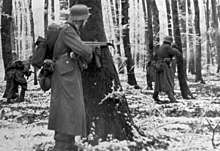Volksgrenadier
Volksgrenadier was the name given to a type of German Army division formed in the Autumn of 1944 after the double loss of Army Group Center to the Soviets in Operation Bagration and the Fifth Panzer Army to the Allies in Normandy. The name itself was intended to build morale, appealing at once to nationalism (Volk) and Germany's older military traditions (Grenadier). Germany formed 78 VGDs during the war. Volksgrenadier divisions were professional military formations with effective weapons and equipment, unlike the unrelated Volkssturm militia.
History and organisation
The strategic emergency and concomitant manpower shortage resulting from the losses in mid-1944 required the creation of infantry divisions that economized on personnel and emphasized defensive strength over offensive strength. The Volksgrenadier divisions met this need by using only six line infantry battalions instead of the normal nine for infantry divisions – already a common reality for many existing divisions. The units also had a higher proportion of submachine guns and light automatic weapons and thus relied more on short-range firepower than in standard German Army infantry units. Automatic weapons like the new Sturmgewehr 44 and anti-tank weaponry like the single shot panzerfaust were also used by Volksgrenadier units. One battalion of one grenadier regiment and the two companies of the engineer battalion were assigned bicycles for transportation instead of motor vehicles.
They were organized around small cadres of hardened veteran soldiers, NCOs and officers, and then bulked out with anything the Replacement Army could supply: "jobless" personnel of the shrinking Kriegsmarine and Luftwaffe, wounded soldiers from broken formations returning to duty from hospitals, older men who would have been considered too old or too unfit for the peacetime army and teenagers were recruited into the ranks.
Organisation[1]
- Division headquarters
- Füsilier company or battalion (bicycle-mounted)
- Company headquarters
- Submachine gun platoon
- Submachine gun platoon
- Rifle platoon
- Heavy weapons platoon
- Infantry howitzer section
- Signal battalion
- Battalion headquarters
- Telephone company
- Radio company
- Supply platoon
- Grenadier regiment
- Regimental headquarters
- Regimental headquarters company
- Infantry battalion
- Infantry battalion
- Infantry howitzer company
- Antitank rocket launcher company
- Grenadier regiment
- Grenadier regiment
- Artillery regiment
- Regimental headquarters
- Regimental headquarters battery
- 75 mm gun battalion
- 105 mm gun/howitzer battalion
- 105 mm gun/howitzer battalion
- 150 mm howitzer battalion
- Antitank battalion
- Battalion headquarters
- Battalion headquarters company
- Antitank company (motorized)
- Antitank company (self-propelled)
- Antiaircraft company (self-propelled)
- Engineer battalion
- Battalion headquarters company
- Engineer company (bicycle-mounted)
- Engineer company (bicycle-mounted)
- Supply regiment
- Supply troops
- Ordnance company
- Maintenance platoon
- Administrative troops
- Medical troops
- Veterinary company
- Field post office
Battle
Volksgrenadier divisions participated in the Battle of the Bulge, the defense of the Siegfried Line and Eastern Front, and in the final battles in Germany. Some divisions acquitted themselves very well and fought tenaciously while others were rushed into battle with a minimum of training and thus performed very poorly. Several Volksgrenadier divisions, especially those made up of "jobless" Wehrmacht personnel drawn from the Kriegsmarine and the Luftwaffe, often displayed high motivation and morale which resulted in good cohesion and military effectiveness against the Allied forces in the last eight or so months (about October 1944 through May 1945) of the war in Europe.
References
- Handbook on German Military Forces. Washington, D.C.: United States Government Printing Officer. 1945. p. II-18.
|first=missing|last=(help)
- Davies, W.J.K. (1981). German Army Handbook 1939-1945 (Second U.S. ed.). New York: Arco Publishing. ISBN 0-668-04291-5.
- Nash, Douglas E., Victory Was Beyond Their Grasp: With the 272nd Volks-Grenadier Division from the Hurtgen Forest to the Heart of the Reich. Bedford, PA: Aberjona Press, 2008)
